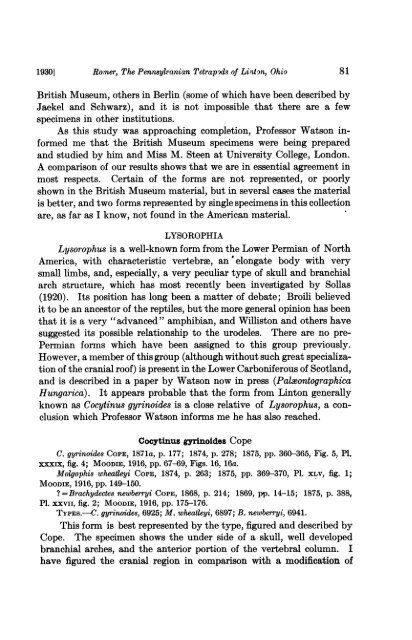View/Open - American Museum of Natural History
View/Open - American Museum of Natural History
View/Open - American Museum of Natural History
You also want an ePaper? Increase the reach of your titles
YUMPU automatically turns print PDFs into web optimized ePapers that Google loves.
19301 Romer, The Pennsylvanian Tetrap9ds <strong>of</strong> Lintrn, Ohio<br />
81<br />
British <strong>Museum</strong>, others in Berlin (some <strong>of</strong> which have been described by<br />
Jaekel and Schwarz), and it is not impossible that there are a few<br />
specimens in other institutions.<br />
As this study was approaching completion, Pr<strong>of</strong>essor Watson informed<br />
me that the British <strong>Museum</strong> specimens were being prepared<br />
and studied by him and Miss M. Steen at University College, London.<br />
A comparison <strong>of</strong> our results shows that we are in essential agreement in<br />
most respects. Certain <strong>of</strong> the forms are not represented, or poorly<br />
shown in the British <strong>Museum</strong> material, but in several cases the material<br />
is better, and two forms represented by single specimens in this collection<br />
are, as far as I know, not found in the <strong>American</strong> material.<br />
LYSOROPHIA<br />
Lysorophus is a well-known form from the Lower Permian <strong>of</strong> North<br />
America, with characteristic vertebrae, an elongate body with very<br />
small limbs, and, especially, a very peculiar type <strong>of</strong> skull and branchial<br />
arch structure, which has most recently been investigated by Sollas<br />
(1920). Its position has long been a matter <strong>of</strong> debate; Broili believed<br />
it to be an ancestor <strong>of</strong> the reptiles, but the more general opinion has been<br />
that it is a very "advanced " amphibian, and Williston and others have<br />
suggested its possible relationship to the urodeles. There are no pre-<br />
Permian forms which have been assigned to this group previously.<br />
However, a member <strong>of</strong> this group (although without such great specialization<br />
<strong>of</strong> the cranial ro<strong>of</strong>) is present in the Lower Carboniferous <strong>of</strong> Scotland,<br />
and is described in a paper by Watson now in press (Palzeontographica<br />
Hungarica). It appears probable that the form from Linton generally<br />
known as Cocytinus gyrinoides is a close relative <strong>of</strong> Lysorophus, a conclusion<br />
which Pr<strong>of</strong>essor Watson informs me he has also reached.<br />
Cocytinus gyrinoides Cope<br />
C. gyrinoides COPE, 1871a, p. 177; 1874, p. 278; 1875, pp. 360-365, Fig. 5, P1.<br />
xxxix, fig. 4; MOODIE, 1916, pp. 67-69, Figs. 16, 16a.<br />
Molgophis wheatleyi COPE, 1874, p. 263; 1875, pp. 369-370, P1. XLV, fig. 1;<br />
MOODIE, 1916, pp. 149-150.<br />
? =Brachydectes newberryi COPE, 1868, p. 214; 1869, pp. 14-15; 1875, p. 388,<br />
P1. xxVII, fig. 2; MOODIE, 1916, pp. 175-176.<br />
TYPES.-C. gyrinoides, 6925; M. wheatleyi, 6897; B. newberryi, 6941.<br />
This form is<br />
best represented by the type, figured and described by<br />
Cope. The specimen shows the under side <strong>of</strong> a skull, well developed<br />
branchial arches, and the anterior portion <strong>of</strong> the vertebral column. I<br />
have figured the cranial region in comparison with a modification <strong>of</strong>
















